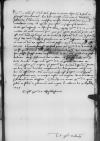Hac hora reverso nuntio meo cum litteris dominorum Johann von Lusian (Jan Luzjański) (*before 1470 – †1551), brother of Fabian von Lusian (Luzjański), Bishop of Ermland (Warmia); 1514-1551 Voivode of Kulm (Chełmno); 1520-1525 Burgrave of Rössel (Reszel) (PSB 18, p. 166-167)
Jan Konopacki Sr (Ioannes de Conopat) (†1530), before 1500 Provost and Treasurer of Marienburg; 1508-1530 Bishop of Kulm (NITECKI)⌊palatinorumJohann von Lusian (Jan Luzjański) (*before 1470 – †1551), brother of Fabian von Lusian (Luzjański), Bishop of Ermland (Warmia); 1514-1551 Voivode of Kulm (Chełmno); 1520-1525 Burgrave of Rössel (Reszel) (PSB 18, p. 166-167)
Jan Konopacki Sr (Ioannes de Conopat) (†1530), before 1500 Provost and Treasurer of Marienburg; 1508-1530 Bishop of Kulm (NITECKI)⌋ et Thorn Town Council ⌊ThorunensiumThorn Town Council ⌋ confestim consedi ad has scribendas, ne quid intercideret morae ad agenda, quae restant in suspensione comiciorum. Mitto igitur responsa et consensus illorum rogoque, Reverendissima Dominatio Vestra non gravetur mittere ad aulam nuntium suum, per quem aperte scribendum puto non esse tutum Council of Royal Prussia the most important local authority in Royal Prussia. It consisted of two bishops (of Ermland (Warmia), who served as the Council’s president, and of Kulm (Chełmno)), three voivodes (of Kulm, Marienburg (Malbork), and Pomerania), three castellans (of Kulm, Elbing (Elbląg), and Gdańsk (Danzig)), three chamberlains (of Kulm, Marienburg, and Pomerania), and representatives of the three Great Prussian Cities – Gdańsk, Thorn (Toruń), and Elbing (ACHREMCZYK 2016, p. 17-18)⌊dominis consiliariisCouncil of Royal Prussia the most important local authority in Royal Prussia. It consisted of two bishops (of Ermland (Warmia), who served as the Council’s president, and of Kulm (Chełmno)), three voivodes (of Kulm, Marienburg (Malbork), and Pomerania), three castellans (of Kulm, Elbing (Elbląg), and Gdańsk (Danzig)), three chamberlains (of Kulm, Marienburg, and Pomerania), and representatives of the three Great Prussian Cities – Gdańsk, Thorn (Toruń), and Elbing (ACHREMCZYK 2016, p. 17-18)⌋, ut conveniant ad constitutum diem nec id futurum, ne, si hoc iterum indulgeri precabimur, ut videlicet differatur conventus, cum ante eum diem vix expediri nuntius possit, iterum dicamur post festum venire. Conveniet fortasse ut scrib petat etiam Reverendissima Dominatio Vestra de rationibus accisae orig. axise⌈accisaeaccisae orig. axise⌉, quod monet dominus Georg von Baysen (Jerzy Bażyński) (*1469 – †1546), 1503-1512 Chamberlain of Marienburg (Malbork); 1512-1546 Voivode of Marienburg (PSB 1, p. 377)⌊palatinus MarieburgensisGeorg von Baysen (Jerzy Bażyński) (*1469 – †1546), 1503-1512 Chamberlain of Marienburg (Malbork); 1512-1546 Voivode of Marienburg (PSB 1, p. 377)⌋. Qua ratione id fieri possit, scripsi antea consilium meum s(acrae) or s(erenissimae)⌈s(acrae)s(acrae) or s(erenissimae)⌉ Sigismund I Jagiellon (Zygmunt I) (*1467 – †1548), King of Poland and Grand Duke of Lithuania (1506-1548); Duke of Głogów (Glogau) (1499-1506), Duke of Opava (1501-1506), Governor of Silesia (1504-1506); son of King Kazimierz IV Jagiellon and Elisabeth of Austria⌊regiae maiestatiSigismund I Jagiellon (Zygmunt I) (*1467 – †1548), King of Poland and Grand Duke of Lithuania (1506-1548); Duke of Głogów (Glogau) (1499-1506), Duke of Opava (1501-1506), Governor of Silesia (1504-1506); son of King Kazimierz IV Jagiellon and Elisabeth of Austria⌋, quod tum probabatur. Mihi festinanti has mittere, non superfuit superinscribed in place of crossed-out sumpsi mihi⌈sumpsi mihi superfuit superfuit superinscribed in place of crossed-out sumpsi mihi⌉ otium scribendi ad aulam. Rogo autem, Reverendissima Dominatio Vestra non gravetur admittere, ut nuntius Ipsius, quem missura est, parvum hoc itineris dispendium faciat, ut Löbau (Lubawa, Lubavia), town in northern Poland, Kulm Land (Ziemia Chełmińska), ca. 67 km E of Graudenz (Grudziądz), the main seat of the bishops of Kulm (Chełmno)⌊hucLöbau (Lubawa, Lubavia), town in northern Poland, Kulm Land (Ziemia Chełmińska), ca. 67 km E of Graudenz (Grudziądz), the main seat of the bishops of Kulm (Chełmno)⌋ ad me divertat, accepturus hic litteras paratas, etiam si me hic non offenderit. Nam animus mihi est propter invalescentem hic pestilentiae vim in Althausen (Starogród, Antiquum Castrum), town on the Vistula river, ca. 1.5 km S of Kulm, initial location of Kulm; given to the Kulm cathedral by Alexander Jagiellon, it was the summer residence of the Kulm bishops⌊Antiquum CastrumAlthausen (Starogród, Antiquum Castrum), town on the Vistula river, ca. 1.5 km S of Kulm, initial location of Kulm; given to the Kulm cathedral by Alexander Jagiellon, it was the summer residence of the Kulm bishops⌋ me recipere, donec dominus Deus salubriorem auram concesserit. Commendo me amori Reverendissimae Dominationis Vestrae, quam salvam et felicem in plurimam aetatem cupio.


 AAWO, AB., D. 2, f. 119v
AAWO, AB., D. 2, f. 119v